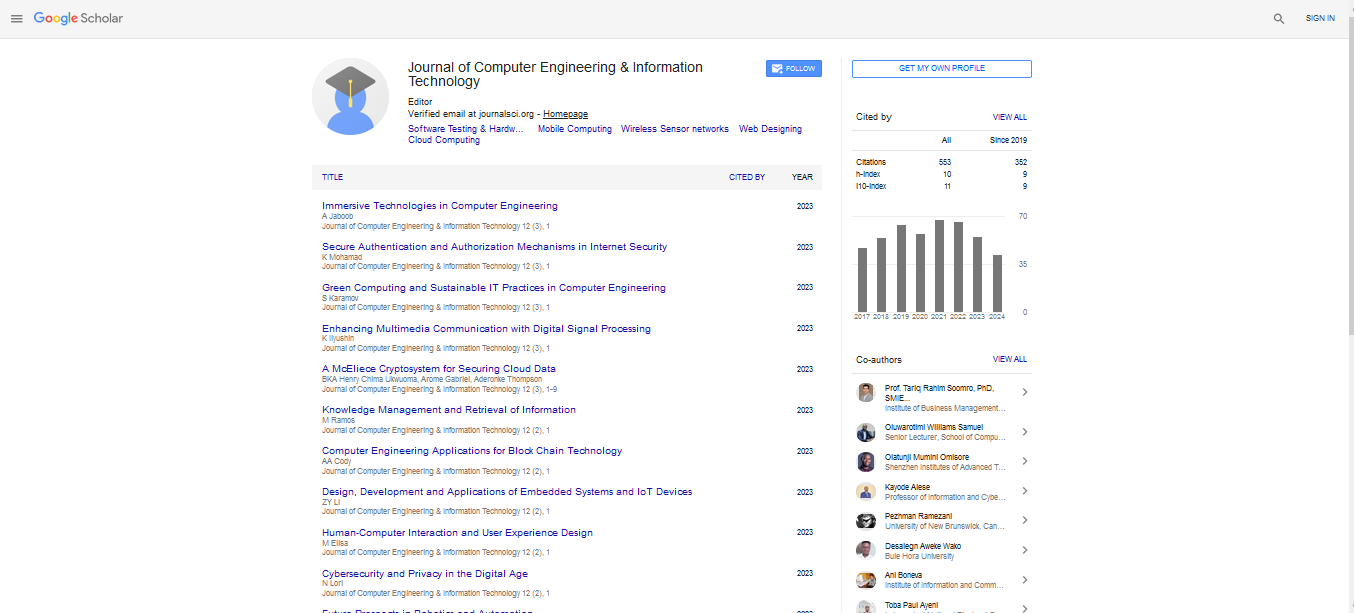Editorial, Jceit Vol: 14 Issue: 1
Embedded Systems: Integrating Computing into Everyday Devices
Yu Huang*
Department of Computer Science, Anhui Science and Technology University, Bengbu, China
- *Corresponding Author:
- Yu Huang
Department of Computer Science, Anhui Science and Technology University, Bengbu, China
E-mail: yu@huang.cn
Received: 01-Jan-2025, Manuscript No. jceit-25-169312; Editor assigned: 4-Jan-2025, Pre-QC No. jceit-25-169312 (PQ); Reviewed: 20-Jan-2025, QC No jceit-25-169312; Revised: 27-Jan-2025, Manuscript No. jceit-25-169312 (R); Published: 31-Jan-2025, DOI: 10.4172/2324-9307.1000335
Citation: Yu H (2025) Embedded Systems: Integrating Computing into Everyday Devices. J Comput Eng Inf Technol 14: 335
Introduction
Embedded systems have become an integral part of modern technology, enabling intelligence and automation in a wide range of devices beyond traditional computers [1]. An embedded system is a specialized computing system designed to perform dedicated functions within larger mechanical or electrical systems. Unlike general-purpose computers, embedded systems are optimized for specific tasks, often with real-time computing constraints, making them crucial in industries such as automotive, healthcare, consumer electronics, and telecommunications.
What is an Embedded System?
An embedded system consists of a microcontroller or microprocessor, memory, input/output interfaces, and software, all integrated to perform particular operations [2]. It is “embedded” as part of a complete device, often operating with limited resources and strict performance requirements.
Key characteristics of embedded systems include:
- Dedicated Functionality: Designed to carry out specific tasks rather than general computing.
- Real-Time Operation: Many embedded systems must process [3] data and respond within strict time limits.
- Resource Constraints: Limited memory, processing power, and energy consumption.
- Reliability and Stability: Often deployed in critical environments requiring consistent performance over long periods [4].
Components of Embedded Systems
Typical embedded systems comprise the following components:
- Processor: Microcontroller (MCU) or microprocessor to execute instructions.
- Memory: Includes ROM/Flash for firmware and RAM for runtime data.
- Input/Output Interfaces: Sensors, actuators, communication ports.
- Software/Firmware: Real-time operating system (RTOS) or bare-metal code tailored for the task.
Applications of Embedded Systems
Embedded systems are everywhere, powering a vast array of applications:
- Automotive: Engine control units, anti-lock braking systems, infotainment.
- Consumer Electronics: Smart TVs, washing machines, digital cameras.
- Healthcare: Pacemakers, medical imaging devices [5], patient monitoring systems.
- Industrial Automation: Robotics, process controllers, instrumentation.
- Telecommunications: Routers, switches, mobile base stations.
Challenges and Emerging Trends
Designing embedded systems involves addressing challenges such as ensuring security, managing power efficiency, and handling real-time constraints. The rise of the Internet of Things (IoT) has further expanded embedded system applications by connecting devices to the internet for smarter interaction.
Emerging trends include:
- Edge Computing: Processing data locally on embedded devices to reduce latency.
- AI Integration: Embedding machine learning models to enable smarter decision-making.
- Security Enhancements: Protecting embedded systems from cyber threats.
- Energy Harvesting: Utilizing renewable energy sources to power devices.
Conclusion
Embedded systems serve as the invisible backbone of modern technology, seamlessly integrating computing power into everyday objects and critical infrastructure. Their specialized design enables efficient, reliable, and real-time operation across diverse fields. As technology advances, embedded systems will continue to evolve, driving innovation in IoT, AI, and beyond, shaping the future of smart devices and automated systems.
References
- Merkel D (2014) Docker: Lightweight Linux containers for consistent development and deployment. Linux Journal 2014.
- Docker, Inc. (2024). What is a container?
- Red Hat (2023) Docker vs. Podman: Whatâ??s the difference?
- Kubernetes Documentation. (2021). Dockershim Deprecation FAQ.
- IBM. (2023). A complete guide to containerization.
Indexed at, Google Scholar, Crossref
Indexed at, Google Scholar, Crossref
Indexed at, Google Scholar, Crossref
Indexed at, Google Scholar, Crossref
 Spanish
Spanish  Chinese
Chinese  Russian
Russian  German
German  French
French  Japanese
Japanese  Portuguese
Portuguese  Hindi
Hindi 